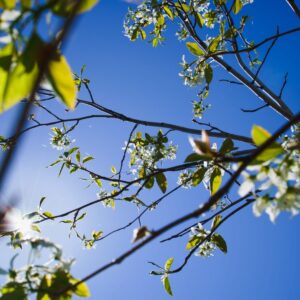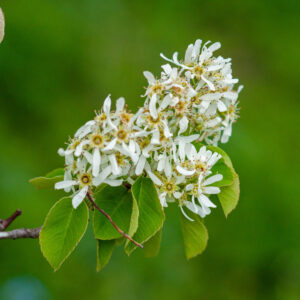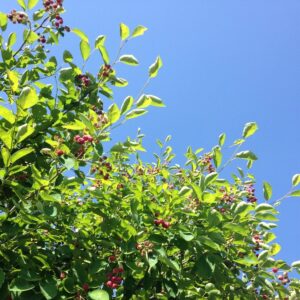Wholesale Serviceberry Shrubs in Michigan
Cold Stream Farm is the proud purveyor of wholesale and retail serviceberry shrubs from our headquarters in Free Soil, Michigan. We supply Saskatoon (Amelanchier alnifolia), Allegheny (Amelanchier laevis), and Shadbush (Amelanchier canadensis) Serviceberry with no minimum order required.
Differentiating Between Serviceberry Species
Serviceberry is the common name for plants from the genus Amelanchier, which is within the Rose family. There are approximately twenty species of serviceberry shrubs, most of which are native in the United States and Canada.
A few other serviceberries are found in Europe in Asia, and many of the species have several names and nicknames. The term “service” in “serviceberry” refers to its common use in Easter services, as the plant blooms in spring.
Saskatoon Serviceberry (Amelanchier alnifolia)
One of the most common species of Serviceberry is the Saskatoon serviceberry, which is native to the northwestern United States and Canada. The city of Saskatoon, Saskatchewan derives its name from this plant, which can be recognized by its wide, white flowers and small purple berries.
Extremely common in North American forests, the Saskatoon serviceberry is also called the Pacific serviceberry, Pigeon berry, western serviceberry, dwarf shadbush, alder-leaf shadbush, juneberry, western juneberry, or chuckley pear.
Check our current Saskatoon Serviceberry (Amelanchier alnifolia) availability.
Allegheny Serviceberry (Amelanchier laevis)
On the other side of the continent, it is much more common to see Allegheny Serviceberry (Amelanchier laevis) throughout the eastern United States and Canada. Growing in the wild, this species is far south as the state of Georgia and north all the way to Newfoundland. The Allegheny Serviceberry plant may also be called smooth shadbush or smooth serviceberry.
See our availability for Allegheny Serviceberry (Amelanchier laevis).
Shadbush Serviceberry (Amelanchier canadensis)
Lastly, the Shadbush Serviceberry (Amelanchier canadensis) shrub is found in eastern North America, primarily sprouting up in wet regions of the United States and Canada. A Shadbush Serviceberry is similar looking to the Saskatoon Serviceberry, which has slightly different white flowers and rich purple-colored berries.
The Shadbush Serviceberry is also known as the thicket shadblow, Currant-tree, downy serviceberry, shadbush, oblong leaf juneberry, Chuckle Berry, Sugarplum, shadblow serviceberry, shadblow bush, and the Canadian serviceberry.
Click to see our current stock of Shadbush Serviceberry (Amelanchier canadensis).
Things to know before your Purchase Serviceberry Shrubs
There are many subtle differences between serviceberry species that help them thrive in unique environments. Below, we will outline some of the general characteristics across the genus with the differences to pay attention most closely to.
Size and Appearance
Saskatoon serviceberry shrubs will typically reach a mature height of between 10 and 20 feet. Ascending in potential size, an Allegheny serviceberry can be expected to reach 25 feet, while Shadbush plants reach as high as 30 feet when fully grown. All species within the Amelanchier genus have green, ellipse-shaped leaves and white flowers each with five separate petals. Their fruits are poms (red to purple), which are like berries.
Ideal Growing Conditions
Serviceberry shrubs prefer moist soil conditions, especially Shadbrush which is native to swampland. Serviceberries tolerate partial shade but prefer full sun if possible. Ideally, the soil is slightly acidic when growing serviceberries shrubs, and they are best placed along a stream or next to a pond. Depending on the species, a serviceberry plant may perform best in USDA zones 2 through 8.
The Benefits and Uses of Serviceberry Shrubs
Thanks to their attractive berries and flowers, most serviceberry shrubs are grown ornamentally in a garden or next to a water feature. Some serviceberry shrubs can even be made into bonsai.
Once they are ripe, serviceberries are completely edible for both people and animals. The fruits are common in pies, jams, and more. There have been many medicinal benefits of serviceberries shrubs discovered throughout the years, making use of the plant’s berries, flowers, and bark.
Wildlife and Ecology
In North America, serviceberry shrubs are one of the most popular foods for nearly one hundred different species of animal and bird. Some of the most frequent customers include orioles, cardinals, mockingbirds, woodpeckers, doves, rabbits, squirrels, chipmunks, deer, and more.
Of course, it’s not just about the berries. If you are seeing holes in your serviceberry leaves, then chances are that a caterpillar or other insect has made your plant its home.
Common Challenges with Serviceberries
Due to its animal attraction, immature serviceberry shrubs may be damaged or mauled before reaching full height. The plant should be protected from ground damage, ideally placed in a raised bed. As a water-demanding plant, frequent monitoring and watering may also be required for a serviceberry plant to thrive.
Contact Us Today
Are you ready to purchase one or more serviceberry shrubs? You can order online from our current serviceberry stock. If you have questions about future availability or shipping information, contact us so that we can help with your order. Cold Stream Farm typically only has serviceberry supply in the spring, so please plan accordingly.



